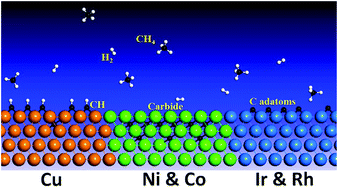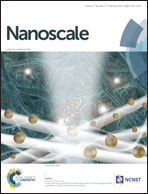What are the active carbon species during graphene chemical vapor deposition growth?†
Abstract
The dissociation of carbon feedstock is a crucial step for understanding the mechanism of graphene chemical vapor deposition (CVD) growth. Using first-principles calculations, we performed a comprehensive theoretical study for the population of various active carbon species, including carbon monomers and various radicals, CHi (i = 1, 2, 3, 4), on four representative transition-metal surfaces, Cu(111), Ni(111), Ir(111) and Rh(111), under different experimental conditions. On the Cu surface, which is less active, the population of CH and C monomers at the subsurface is found to be very high and thus they are the most important precursors for graphene CVD growth. On the Ni surface, which is more active than Cu, C monomers at the subsurface dominate graphene CVD growth under most experimental conditions. In contrast, on the active Ir and Rh surfaces, C monomers on the surfaces are found to be very stable and thus are the main precursors for graphene growth. This study shows that the mechanism of graphene CVD growth depends on the activity of catalyst surfaces and the detailed graphene growth process at the atomic level can be controlled by varying the temperature or partial pressure of hydrogen.


 Please wait while we load your content...
Please wait while we load your content...